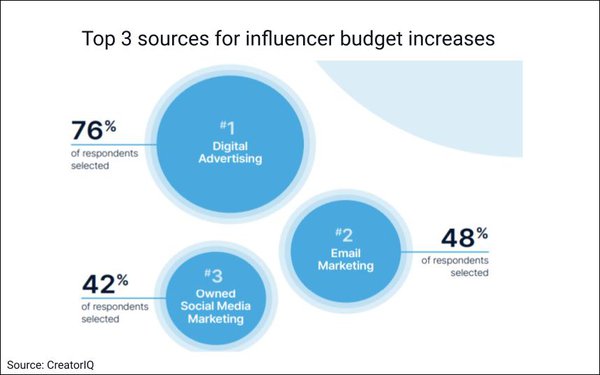
Two-thirds (67%) of brand and agency
marketers recently surveyed by creator marketing platform CreatorIQ report increasing their investments in influencer marketing this year.
More than a quarter (26%) said that their influencer
budgets were flat to 2022, and 7% reporting decreasing those investments.
The survey included 132 marketers who directly engage in influencer marketing, with 68% from brands and 32% on the
agency side. The respondents were from organizations spanning all sizes, with 37% from companies with more than 1,000 employees. For questions that allowed multiple responses, results do not add up to
100%.
Among brands whose influencer budgets increased, 24% reported working from net-new budgets, while 76% said they were diverting funds from other types of paid types marketing.
About two-thirds (also 76%) reported shifting some dollars from digital advertising, 48% said they moved some money from email marketing, and 42% reported diverting funds from owned social media
marketing.
advertisement
advertisement
Asked about the most useful metrics for justifying influencer marketing investment, 51% cited engagement, 28% conversion and 11% impressions.
But while influencer marketing
is typically considered an engagement/top-of-funnel tactic, 61% of respondents claimed that they could attribute some sales to creator content shared on social media, 33% said they could at least
partially attribute that type of marketing to sales, and just 6% said they couldn’t attribute any sales to it.
Asked to specify how they draw a direct correlation between creator content
and sales, respondents primarily cited conversion rates, click-throughs to their websites and marketing mix modeling.
Marketers attributed creator-led content conversions to the marketing
being “authentic and relatable” (48%), “aspirational and instructive” (21%), entertaining (15%) and easier to reach consumers (15%).
Two-thirds (64%) said they tap
organic brand fans for influencer marketing, 45% use software to identify appropriate influencers, and 41% use past partnerships.
Three-quarters (77%) report having converted organic fans into
creator partners in the past year, and 76% have used user-generated content in paid advertising in the past year.
The most common influencer compensation methods are pay-per-content (used by
60%), affiliate commissions based on sales (45%) and performance based on clicks (33%). Pay-per-content was cited as most effective by 41%, commissions by 29%, and clicks by 16%.